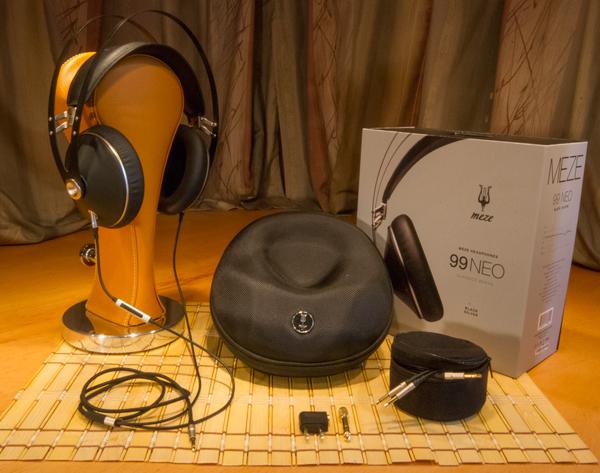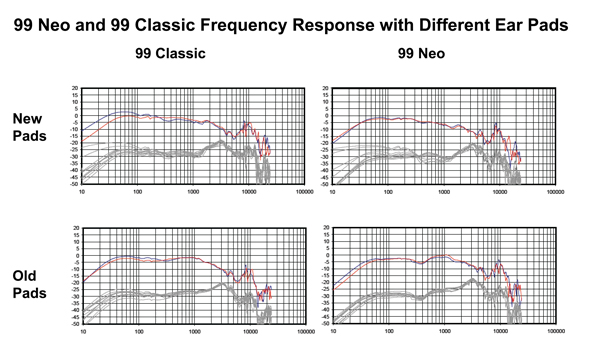| Columns Retired Columns & Blogs |
Meze 99 Neo Around-Ear Sealed Headphones

This story originally appeared at InnerFidelity.com
Meze 99 Neo ($249)
Just over a year ago I wrote about the preceding Meze model 99 Classic and liked it very much. The Meze 99 Neo is a very similar headphone; the most significant differences are that the 99 Neo has a plastic housing vs. the wooden capsule housings of the 99 Classic, and the earpads have been changed to be a bit larger on the new model. Due to the nature of my findings, I'm not going to do a full review here of the new model, but will rather dive right into what I see as a problem with these new cans.
In my previous review of the 99 Classics I wrote this about the earpads:
My point here is that the 99 Classics are actually more generous front to back than the others, and a little under average top to bottom. Depth is hard to measure, but it did seem the 99 Classics were on the shallow side in the group. So, yes, I find them cozy around the ear, but not cramped relative to others in the category. I had no comfort problems in long term listening other than them getting a bit warm after a while. But just a bit.
It turns out that while my slightly smaller than average male sized ears didn't have too much problem with the 99 Classic, others did commonly complain in on-line comments. Like any responsible company, Meze took these comments to heart and started working on a more roomy earpad for the 99 Classic. Evidently, there's been a couple of iterations of this pad, and version three is already shipping on the 99 Classic and came on the 99 Neo sent to me as a pre-production sample.
Any DIY headphone hobbyist who has spent any time playing around with earpads will tell you small changes to the pad can create some very significant differences in sound quality, so I was quite interested if Meze managed to make a little more room in the pads without harming sound quality. I'm just going to mix subjective and objective observations together as I explain what I found. I Measured both the 99 Classic and 99 Neo with both the new and the old pads. If you'd like to see the full measurement sheets I'm put them together in a little .pdf booklet here.
The first thing I noticed when listening to the new 99 Neo was that the bass seemed a bit stronger and looser with more distortion; and also seemed more boxy sounding than the 99 Classic. When I went to measure them, I found their seal very sensitive; either they sealed really well, and created a big bass hump, or they didn't and there wasn't much of a bass hump.

When I do my measurements, I can watch the 30Hz square wave on an oscilloscope as I position the cans on the measurement head. With the 99 Neo, the square wave would switch between the bass heavy response (red plot above) to the more bass light response (green) with very little stability between. In my experience, this happens when the headphones have a very tightly sealed ear chamber. Many manufacturers have damped venting systems for the ear chamber to reduce this problem.
I spent some time subjectively comparing the two headphones and felt the older 99 Classic was significantly clearer and uncolored sounding, so I decided to swap pads and remeasure to see if the difference was just the pads or if there was some other differences in the headphones as well. In the two sets of plots below, I compare frequency and impulse response performance for all three permutations of the headphones.

In the plots above, you can see that the raw frequency response plots (gray lines) that are taken in various positions around the ear show significantly more variability with the new pads compared to the old pads. I have to say that with the new pads I did try to make the measurements as close as possible, but did include one of the oddly sealing measurements in each set with the new pads. My point here is the graphs might have looked quite a bit more variable had I not been trying to keep the measurements as consistant as possible with the single exception.
You can also see that the 99 Neo has an inflection in the FR curve at about 400Hz with both pads, but with the new pad there is quite a bit of tonal change occurring around this frequency. Variability with the old pad is again less, but the inflection point remains. The older 99 Classic does not have this inflection point, so I expect there's something else different between the two headphones other than the pad and housing material.

The above plots compare the impulse responses of the four permutations. It's pretty clear that the 99 Classic has significantly more noise following the initial transient with the newer pads. It's not quite as clear with the 99 Neo, but subsequent noise is slightly lower.
Summary
After listening and measuring, I feel like Meze has gone backwards with these pads. The sound is more colored and uneven, and changes to the sound with headphone movement on the head is clearly audible. The new pad has taken the 99 Classic from "excellent" to "also ran" status. I preferred the sound of the ATH-M50x to either Meze when using the new pads.
I will be requesting a current example of the 99 Classic and a production sample of the 99 Neo to reconsider the 99 Classic's "Wall of Fame" status.
- Log in or register to post comments




































